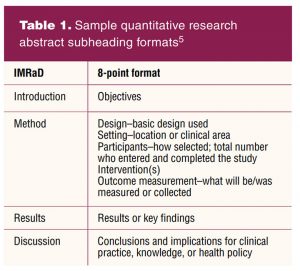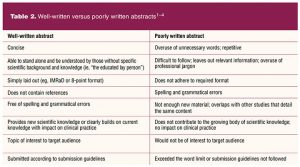As the number and quality of original research focused on women’s healthcare steadily rises, so does the need to disseminate the research findings to the global scientific community through publication or, more frequently, presentation at a professional conference. It is impossible, however, for journal editors or conference reviewers to read full, detailed manuscripts to determine if the research is a good fit for a journal or a specific conference. An abstract, or a deliberate, condensed summary of key aspects of completed research, is the preferred method for introducing one’s research to excite and entice an editor or reviewer to either read a full manuscript or include the research within a conference’s agenda. The pool of applicants looking to disseminate their research can be crowded, so constructing a well-written abstract to stand out among the others is crucial. Writing a great abstract, however, can be difficult. In this article, I will discuss the main components of a quantitative research abstract and provide tips and suggestions for constructing it in an arresting manner.
The title
Submitting an abstract to a national conference, meeting, or publication demonstrates one’s connection to a topic and helps develop one’s national reputation.1,2 However, the abstract needs to first grab an editor or reviewer’s attention and the best way to do that is through an eye-catching title. The title should use the fewest possible words to provide a clear indication of the subject, identify the main issue, and set the expectation about what follows.1,3 The title should arouse and allure the reader to want to learn more. Thus, the title needs to be written carefully to avoid the use of technical terminology that could isolate one’s work from a wider audience.1 Humor must be used prudently and only if it evokes a provocative title. Keep in mind what may be humorous to one person may be offensive to another.
Objectives
Most organizations require abstracts to list objectives. Objectives are measurable behaviors that a learner or conference attendee should be able to perform after viewing one’s presentation or reading the research article.4 Objectives may or may not be included in the total allowable word count. In either case, objectives must be clear and focused on whether the research findings will affect how someone thinks or feels (ie, attitude), their skills (ie, psychomotor), or their knowledge (ie, cognitive).4 Next, an “action” word is necessary, usually a verb that can be measured (eg, identify, recognize, list) and then some tangible object or unit of measurement specific to the aim of the study. Objectives can often be listed as bullet points or written as two to three brief sentences. Be careful not to use objectives to expand the abstract beyond a word count. The reader should be able to find the content referred to in the objectives within the body of the abstract.
Key words
Authors of research abstracts are often asked to provide key words to reflect the essential topics of the study. Key words not only facilitate computer-based searches and retrieval of related materials but also assist conference organizers or editors to assign reviewers with appropriate expertise on the research topic.1,3 Identifying key words can be done manually or with the assistance of computer or web-based programs. Key words need to be specific and relative to the study; words with broad meanings should be avoided. Abbreviations may be acceptable only if they are firmly and unambiguously established within the field of science.1,3
Structured abstracts
The sponsoring organization, conference, or journal will have specific submission guidelines that identify the format and content a research abstract should contain, including the total word or character count and deadline date for submission. Most quantitative research abstracts follow standard subheadings to clarify content: introduction, method, results, and discussion (IMRaD).5 Variations exist within the IMRaD format (eg, the 8-point format) but each provides a framework common to medical or social science journals or conferences for authors to condense their content into concise, well-written text (Table 1).4 Short, simple sentences written in the present tense without tables, figures, citations, or long quotations are preferred.5

Introduction
Often the shortest section, the introduction may also be called the purpose, aim, or significance section. This section provides some orientation about the research: why it was important, why it was worth doing, or why everyone should read or hear about it.1 It should clearly describe the gap in the research that one’s study fills.2 It summarizes briefly what is known about the topic and provides justification for the study being done.6 Introductions are typically two to three sentences.
Methods
Most researchers find this section the most difficult section to write. It is intended to be only a condensed description of what occurred within the study. Within two to three sentences, the researcher should describe the study population and how they were sampled, the context of the study, the outcome variable that was measured, or other measurements that were made.1,2,6 It is not meant for an exhaustive description of every step of the research process used. One should aim for brevity to describe the most salient aspects of the study method that logically produced the study results.
Results
This is the most important section of an abstract. Here, the researcher is forced to select the most cogent findings of their study that are relevant to answering the research question. Although most research discovers several compelling or interesting findings that may become fertile ground for further research, the results reported within an abstract should only include the primary findings or outcome of the study, even if negative, key secondary outcomes, and significant adverse events, if any.2,6 Relevant statistics like P values, confidence intervals, or odds ratios should be included to add strength and veracity to the study findings.
Implications
The researcher needs to summarize the implications of the results of the study: how they are relevant and how they will impact or improve overall knowledge, clinical practice, or health policy. However, those conclusions should not be overstated by inferring anything that is not directly supported by the study data.2 This section should focus on the primary take home message and provide some perspective of the study’s importance.6 This space is not for discussing broad implications of the study overall but is appropriate for short statements that reflect back to the research question and what the next scientific or clinical steps should be.
Advice from the field
The research abstract holds significant importance: it is the link between research, completed or in progress, being shared with the scientific community or remaining dormant. It can seem daunting to condense all the significant aspects of research into a specific format, often giving the appearance that important details are left out or that the impact of the study is weakened. However, a well-written abstract will capture the key elements of one’s research. Editors, reviewers, or conference sponsors have the critical acumen to identify the merits of research from the limited information provided within an abstract that adheres to the provided format guidelines. Thus, there are certain facets that can distinguish a well-written abstract that will more likely be accepted from one that is poorly written and less likely to be accepted (Table 2).

Prior to submitting an abstract, it is imperative to carefully read the submission guidelines. Specific attention needs to be given to any word or character count limits and those adhered to in the abstract. Grammatical and spelling errors or typos are common, so proofreading the abstract should find these subtle errors. I recommend reading one’s work aloud, taking time to pause after each comma or period to determine if those pauses are correctly placed. Having someone else read the abstract aloud, especially someone who is not familiar with the research or the content of the abstract, will allow fragmented, poorly constructed, or run-on sentences to be more easily identified. Last, it is worth asking a colleague to review the abstract to ensure there is no use of jargon, the main points were highlighted, and the abstract is easy to understand.
Disseminating one’s research is a powerful way to advance science and change clinical practice. Developing a winning abstract takes practice but will improve the likelihood of securing a place at a professional conference and open the gateway to future opportunities, collaborations, or notoriety.
Paul Quinn is Director of Nurse Research and Evidence Based Practice at the Valley Hospital in Ridgewood, New Jersey. The author has no actual or potential conflicts of interest in relation to the contents of this article.
References
- Panton L. Writing an abstract. HIV Nursing. 2016;16:5-6.
- Wood GJ, Morrison RS. Writing abstracts and developing posters for national meetings. J Palliat Med. 2011;14(3):353-359.
- LaPlaca P, Lindgren A, Vanhamme J. How to write really good articles for premier academic journals. Ind Mark Manag. 2018;68:202-209.
- Hartley J, Cabanac G. Thirteen ways to write an abstract. Publications. 2017;05(11):1-7.
- Nakayama T, Hirai N, Yamazaki S, Naito S. Adoption of structured abstracts by general medical journals and information for a structured abstract. J Med Libr Assoc. 2005;93(2):237-242.
- Grech V. WASP (Write a Scientific Paper): preparing an abstract. Early Hum Dev. 2018;125:51-52.

